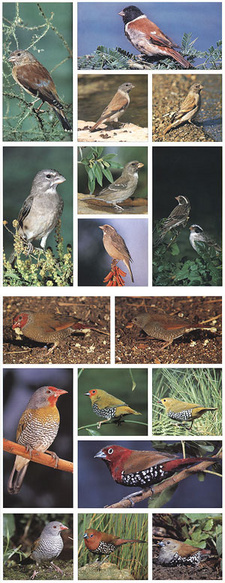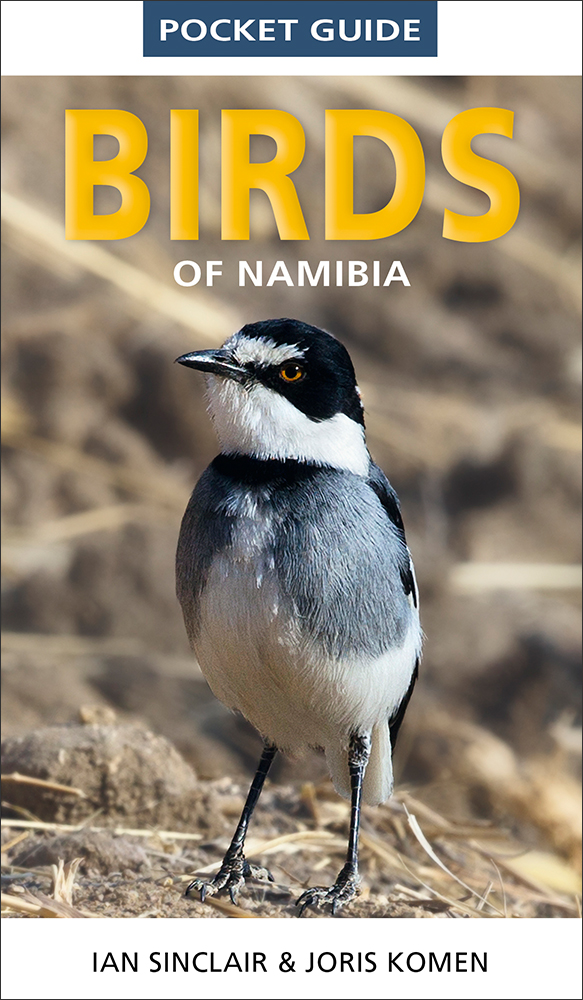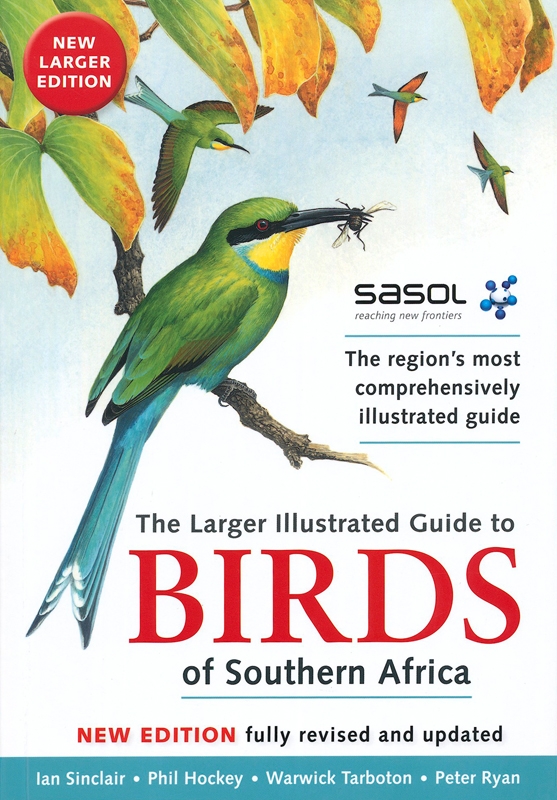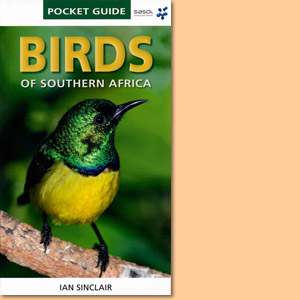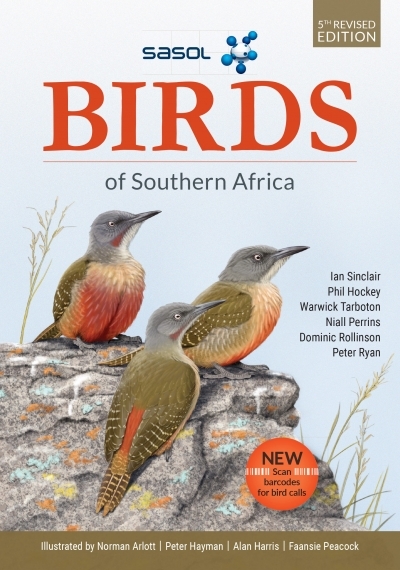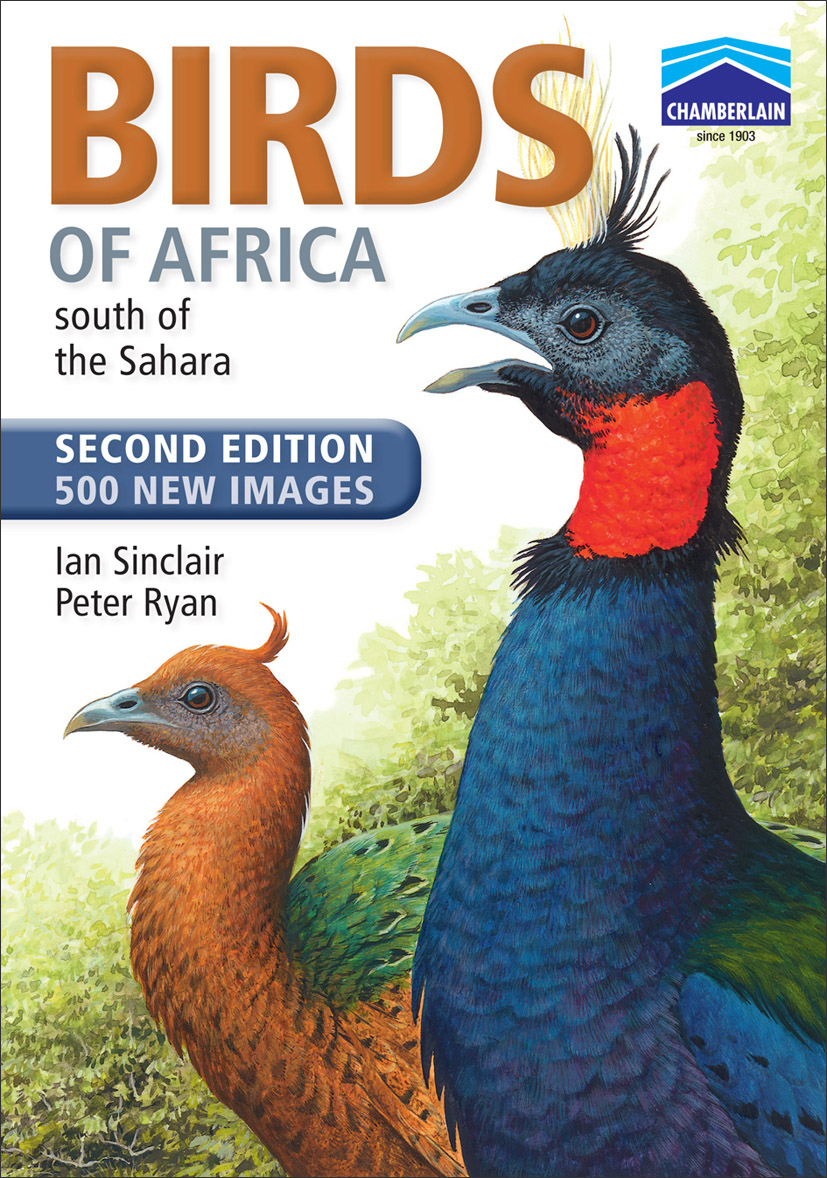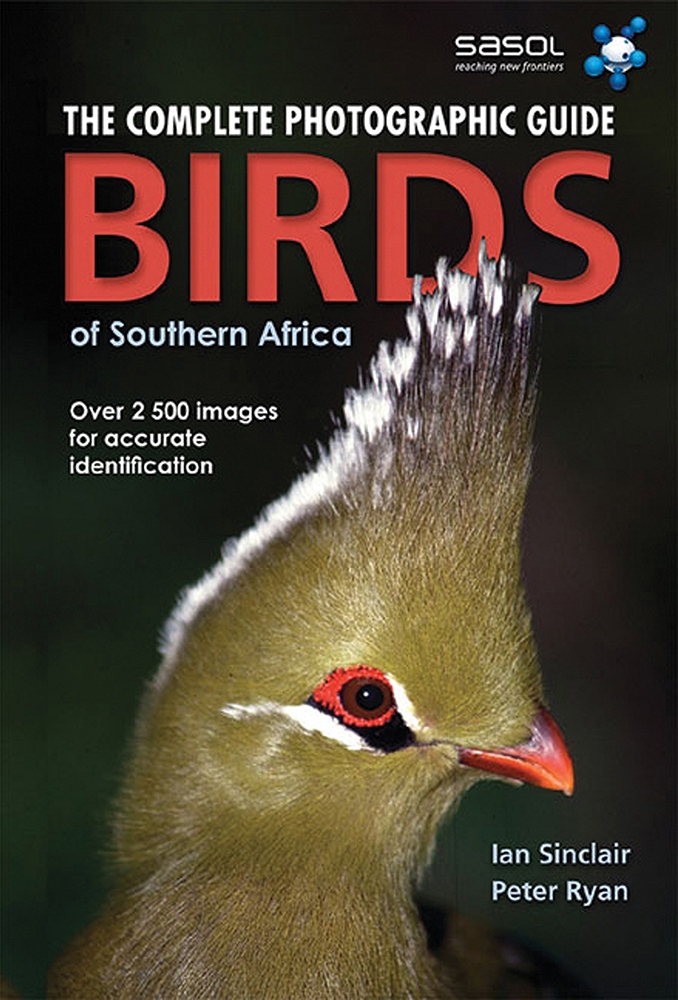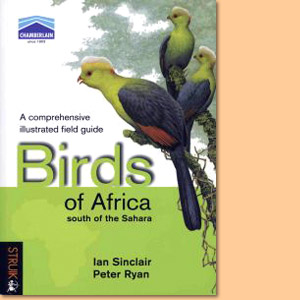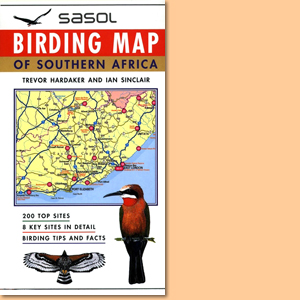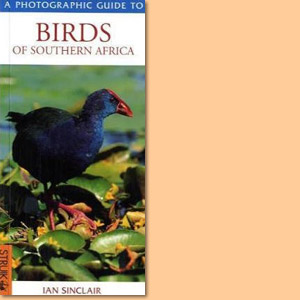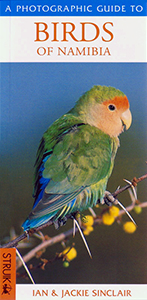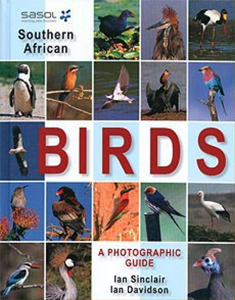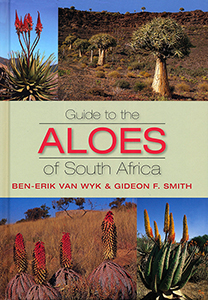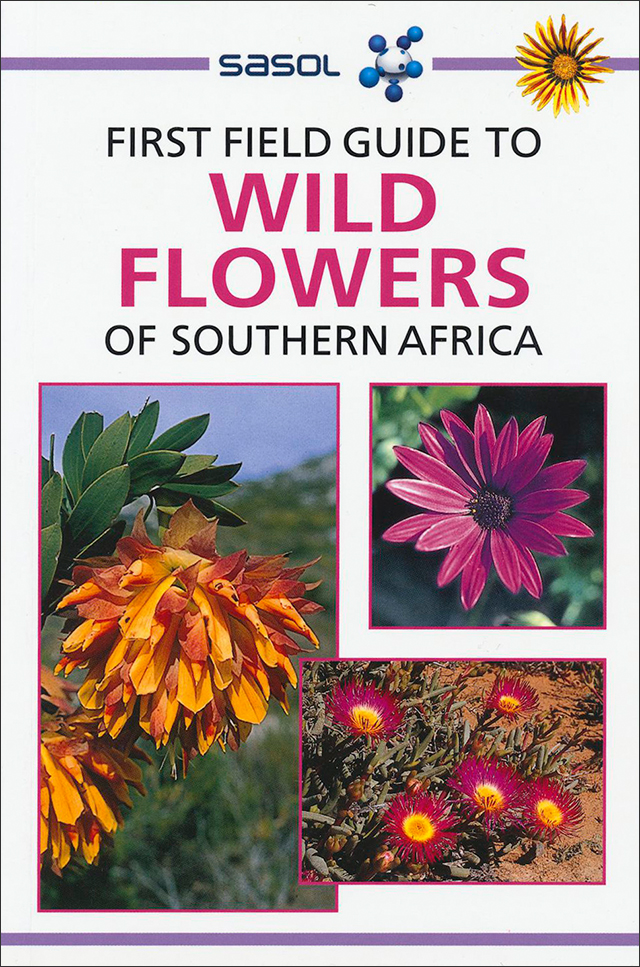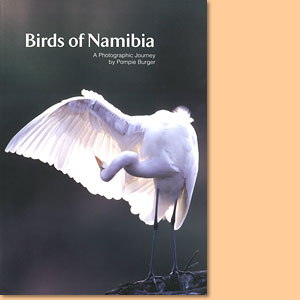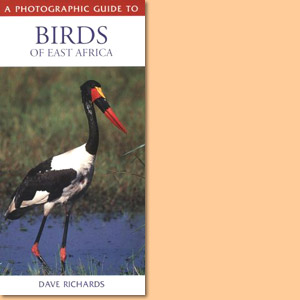Sasol Southern African Birds. A photographic guide by Ian Davidson and Ian Sinclair
Sasol Southern African Birds, a photographic guide covers the southern African sub-region, that is, Africa south of the Kunene River in the west and the Zambezi River in the east, and including the islands off the coasts of Namibia, South Africa and Mozambique.
The distribution maps for each species are the most up-to-date available for the region. Each bird is ascribed both its English and scientific names. The overall length of the bird is also given; where this is exaggerated by an extremely long tail, details of this are given separately, and if there is a notable difference in size between the male and the female, or between breeding and non-breeding plumages, this is also indicated.
The main text provides information on how to identify each bird, its preferred habitat, any behavioural characteristics where these are pertinent to identification, and for many of the species a phonetic rendition of the call or song. The main aim of this book is to convey those field characters that help to identify the bird as quickly as possible. This guide doesn’t describe in detail irrelevant plumage colours, but concentrates rather on those marks or combinations of marks that make a particular species unique. These characters are also compared with those of closely related or similar birds. The arrangement of photographs on the plates allows for easy comparison of like species or of different plumage stages of the same species where the differences are marked. To aid the reader, a simple block design alongside the text indicates (in conjunction with captions) the position of the different species on the plate.
Aims of Sasol Southern African Birds, a photographic guide
This books main purpose is to present more photographs than ever before of birds that occur in southern Africa. Since the publication of the first edition in 1995, the common names of a number of birds have changed, and new information has come to light regarding the ranges of some species.
This book incorporates this new information. The opportunity has also been taken to substitute some images for better examples. The result is a book that goes further than any similar photographic guide by presenting more than 1 000 colour photos, showing a variety of plumages and sexual dimorphism necessary for identification. As with the first edition, we have omitted very rare and vagrant birds, and those that have been seen in the region only a handful of times - perhaps only once - and also those species of which no photographs are available or which, to our knowledge, have never before been photographed. In a few instances, where a species is common but little photo- graphed, we have used colour illustrations.
The arguments for and against using photographs instead of artwork to illustrate a field guide are many. For instance, no single artist can be expected to have the knowledge of the regions many different birds and their diverse range of plumages. And, with regard to photography, light conditions can influence the overall plumage colour and sometimes exaggerate colours. However, the value of the photograph lies in its portrayal of the shape and jizz of the bird, and this is very often lacking in an illustrated field guide. Moreover, photographic bird guides in this large format are ideal for portraying male and female plumages or immatures where they differ significantly from each other. A photograph in sharp focus, taken in good light, renders a true likeness of a bird not normally captured by an artist.
This book is not intended to replace the illustrated field guide; ideally it should be used in conjunction with one to identify a bird. In fact, no single field guide should be used to identify all the species in the region or the many different plumages and age groups that occur. Rather, all available books should be consulted as each will help in identifying those sometimes very difficult groups. In those rare instances where a trick of light has altered a colour, highlighted an unimportant colour or obscured some small detail, reference to a number of depictions of the same species will enable the observer to make a correct identification.
In the field only rarely will a bird remain motionless for long, enabling an observer to study it and absorb every detail. Birds in flight are often moving so rapidly that important details are a blur, but several of the photographs chosen highlight important features and details (not often seen on birds in flight) in action shots. The photographs selected for this volume were chosen from thousands, confirming the very high standard of bird photography in southern Africa. Some are from established professional photographers; others are the work of amateurs, whose tenacity and patience ensured the final image would be superb.
Whether professional or amateur, however, these enthusiastic individuals travelled the length and breadth of the region, from the Drakensberg to the Okavango, from the windswept plains of the west coast to the escarpment edges of the east. No journey, even to the most remote area, was too much to capture that impossible shot of an elusive and furtive bird.
The reader will notice that very few of the images are of birds involved in any breeding activity; the conservation- conscious photographer avoids needless disturbance of birds at their nests. An action and flight shot is, in any case, much more interesting than one of a bird incubating an egg or feeding its young. Indeed, for identification purposes a bird away from the nest is of much more value than one that may be partly obscured because it is sitting on its eggs.
Habitats of Southern African birds:
The habitat in which a bird lives is often, but not always, a clue to its identity: it is highly unlikely, for example, that we would see albatrosses flying around the highest peaks in the Drakensberg or encounter a rockjumper far out to sea. Each species has its own unique set of environmental requirements; some birds may display a very limited habitat choice, for example, several forest species remain within their limited habitat and never venture from it; other birds, however, will move happily between different habitats.
Most habitats in southern Africa have been altered by man to some extent and in some cases this has been beneficial to the bird population of a particular area. Those areas still in pristine or near-pristine condition are very distinct and support bird species peculiar to them. For example, a stroll through a miombo woodland would reveal species like the Spotted Creeper and the White-breasted Cuckooshrike, neither of which would be encountered on a similar stroll through, say, a highland evergreen forest.
The major habitats found in southern Africa include lagoons, estuaries, dams, lakes and pans; the seashore; the oceans (Atlantic and Indian); marshlands and rivers; grass-lands and cultivated lands; forests; savanna; fynbos; and desert and semi-desert. The map provided on the opposite page indicates the boundaries of the main terrestrial habitats found in southern Africa. Lagoons, estuaries, dams, lakes and pans Estuaries, lagoons, lakes, dams and pans are wide-open areas harbouring large numbers of waterfowl and shore-birds; a muddy estuary at low tide can hold thousands of migrant wading birds. Lakes, pans and man-made dams are important in the numbers of waterfowl they sustain and if islands are present they are doubly important as breeding areas.
Seasonally flooded pans or depressions, often with a high saline content, also support large numbers of birds, including many migrant or nomadic species. Seashore The seashore habitat includes the beaches, rocky shorelines, cliffs and bluffs along the high- and low-tide mark. These locations do not hold a vast array of species but many gulls and terns use this zone for roosting, sometimes in very large numbers. A few of our endemic birds are confined to this habitat and at times come under severe pressure from the disturbance caused by, for example, vehicular traffic, sun-bathers and fishermen.
Oceans:
The ocean habitat encompasses the immediate adjacent Indian and Atlantic oceans around our coasts. The Indian Ocean has a warm-water current, and the Atlantic a cold-water current, which to some extent influence the kinds of birds that occur over their surfaces. True seabirds occurring over the oceans include albatrosses, shearwaters and petrels, which usually stay very far out to sea, pass close by near-jutting promontories or headlands, or are storm-driven ashore. Most of the birds occurring in our oceanic waters visit the southern African sub-region on journeys from the South Pole (albatrosses) or from the North Pole (skuas, gulls and petrels).
Marshlands and rivers:
Marshlands and rivers comprise wide and varied habitats, very important for the large numbers of species they support. Some marshes are seasonally flooded and during droughts may go for years in a dry state, whereas others are large and permanent wetlands; the vegetation varies depending on the type of marsh. Stands of tall reeds or impenetrable beds of papyrus tend to dominate some, while others have rank grass growth but are wet and provide cover and protection to the warblers, rails and crakes that frequent them. Rivers may have adjoining marshy areas or tall stands of forests bordering them, important in that this vegetation provides refuge to a wide range of sometimes very rare or specialized birds.
Grasslands (including montane grasslands) and cultivated lands:
The grasslands in the region are one of the fastest diminishing habitats, and very few such areas remain. They support important bird communities such as bustards, cranes, larks and pipits, many of which are endemic. The planting over of these grasslands with exotic trees for the timber industry has created plantations stretching to the horizon but these emerald woods harbour very few birds and are mostly silent green deserts; the same applies to the endless sugar-cane fields, to which very few bird species have adapted. Montane grasslands include the higher reaches of South Africa and Zimbabwe where many interesting species, some endemic, are found above the tree line and in the valleys.
Forests:
Forests cover a very small proportion of southern Africa, occurring as a series of scattered islands along the eastern side of the subcontinent where the rainfall is highest, but are rich in bird species. They encompass natural wooded areas, and can be divided into two distinct types: evergreen montane forests and coastal forests, confined to low-lying areas along the eastern coastal plain. Lowland forests have a distinctly different flora to that of the montane forests, and are generally richer in bird species.
Savanna:
This habitat, often referred to as bushveld, embraces a range of wooded country, from the tall, broad-leaved miombo woodland of Zimbabwe and northern Mozambique to the arid thornveld of the Kalahari. Its essential feature is deciduous trees with an understorey of grass, irrespective of tree type or spacing of the trees. Usually the term woodland is used if the trees form a closed canopy, and parkland if the trees are scattered. There are two distinct divisions within this biome: arid savanna and moist savanna. Arid savanna dominates the western half of the savanna biome and has the greatest diversity of bird species. Moist savanna, dominated by broad-leaved tree species, forms the eastern and northern parts of the region.
Fynbos:
The fynbos habitat is famous for its immense number of plant species, including hundreds of species of Protea, Erica and Restio. Although it lacks a great diversity of birds, those that do occur in this unusual habitat are mostly unique and endemic.
Desert and semi-desert (Namib Desert and Karoo):
This habitat covers the vast low-rainfall area in the west of the region, in which the highest incidence of endemism occurs. Bird populations are small and one can travel long distances through sparse vegetation without glimpsing a single bird. The rainfall is unpredictable and, consequently, many of the species occurring here are nomadic.
Example for bird description: Honeyguides - Family Indicatoridae
Small, short-legged birds, honeyguides are usually drab in coloration and have short, stubby or pointed bills. Species identification is usually based on call, shape of bill and habits. These birds are unique in that they eat beeswax. Brood parasites, some lay their eggs in the nests of barbets and woodpeckers, others in the nests of cisticolas and white-eyes.
Greater Honeyguide - Indicator indicator - Grootheuningwyse 15-20 cm
Similar in size to a Dark-capped Bulbul (see page 196), the male Greater Honeyguide is unmistakable with its pink bill and white cheek patches contrasting with the black throat and dark crown. Females are plainer, being grey above, with a horn-coloured bill and a plain, pale, unmarked throat and breast, differing in this respect from the similar Scaly-throated Honeyguide which has a well-mottled throat and breast. Immatures are creamy yellow below and have a dark brown back.
Males have a fixed call site and will guide man to bees nests. The call is far reaching and sounds like victor, victor. As a brood parasite, this bird uses a wide range of hole-nesting hosts, including kingfishers (see page 148), barbets (see page 162), bee-eaters (see page 152) and hoopoes (see page 156). It is found in a variety of habitats including broad-leaved woodland, forest edges and exotic plantations, but tends to avoid forests.
This is an extract from the book: Sasol Southern African Birds. A photographic guide by Ian Davidson and Ian Sinclair.
Book title: Sasol Southern African Birds
Subtitle: A Photographic Guide
Authors: Ian Davidson; Ian Sinclair
Struik Publishers
Cape Town, South Africa 2006
ISBN-10: 1770072446
ISBN-13: 978-1-77007-244-2
Hardcover, 21x28 cm, 304 pages, throughout colour photos
Davidson, Ian und Sinclair, Ian im Namibiana-Buchangebot
Birds of Namibia (Pocket Guide)
Light and handy for use in the field, Birds of Namibia (Pocket Guide) will give birders an excellent introduction to Namibia's bird life.
Sasol Larger Illustrated Guide to Birds of Southern Africa
This new larger illustrated guide is based on the recently updated fourth edition of the standard-format Sasol Birds of Southern Africa.
Pocket Guide: Birds of Southern Africa
Pocket Guide: Birds of Southern Africa has been designed in pocket-size and primarily for use in the field.
Sasol Birds of Southern Africa
Sasol Birds of Southern Africa remains the region’s most comprehensively illustrated and trusted field guide.
Chamberlain's Birds of Africa south of the Sahara Edition 2010
Despite its exceptional coverage, Chamberlain's Birds of Africa south of the Sahara Edition 2010 is compact enough to use in the field, and follows the standard field guide format.
Complete Photographic Field Guide. Birds of Southern Africa
This complete photographic field guide to birds of Southern Africa describes and illustrates all 958 birds, plus 17 species from Antarctica and Southern Ocean Islands.
Birds of Africa south of the Sahara
Birds of Africa south of the Sahara provides unrivalled coverage of birds south of the Sahara in a single volume.
Sasol Birding Map of Southern Africa
Easy-to-use, illustrated map to 200 of the top birding sites in southern Africa.
A Photographic Guide to Birds of Southern Africa
A Photographic Guide to Birds of Southern Africa is a ideal pocket-sized birder's companion.
A Photographic Guide to Birds of Namibia
This photographic guide is a compact, easy-to-use guide to the most common birds of Namibia.
Sasol Southern African Birds. A Photographic Guide
Sasol Southern African Birds represents one of the best collections of colour photography of Southern African birds and is a distinguishes photographic guide.
Weitere Buchempfehlungen
Guide to the Aloes of South Africa
A wonderful guide to all 155 species aloes found in the South African field and in gardens.
Yellowwood and Chess Pieces. A climber's Guide
Yellowwood and Chess Pieces. A climber's Guide to one of the best trad, multi-pitch, country venues in South Africa.
First Field Guide to Wild Flowers of Southern Africa
First Field Guide to Wild Flowers of Southern Africa is an invaluable resource for the beginner, providing information at a glance through superb photographs, maps and easy-to-read text.
Chamberlain's Birds of Africa south of the Sahara Edition 2010
Despite its exceptional coverage, Chamberlain's Birds of Africa south of the Sahara Edition 2010 is compact enough to use in the field, and follows the standard field guide format.
Complete Photographic Field Guide. Birds of Southern Africa
This complete photographic field guide to birds of Southern Africa describes and illustrates all 958 birds, plus 17 species from Antarctica and Southern Ocean Islands.
Birds of Namibia. A photographic journey
Birds of Namibia is written with the insight and knowledge of an accomplished Namibian observer and, as a photographic journey, highly entertaining as well.
A Photographic Guide to Birds of East Africa
A photographic guide to birds of East Africa is made in a user-friendly format with 350 photographs illustrating each of the 265 species.

